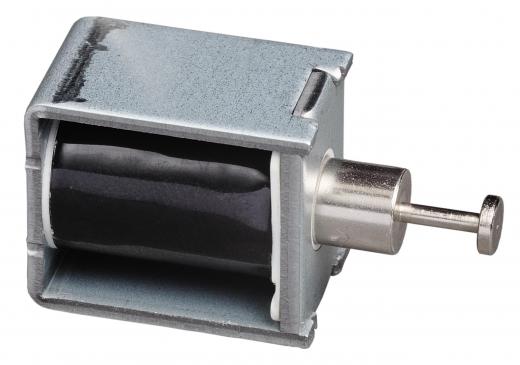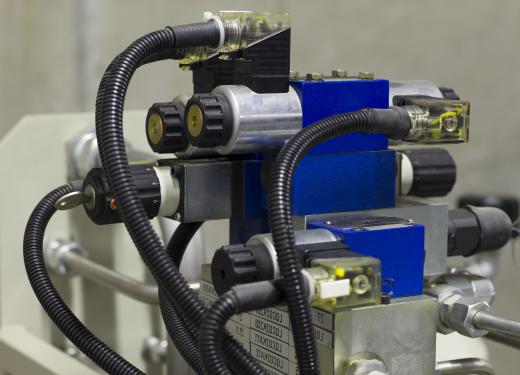An AC solenoid is an electromagnetic switching or actuation device designed specifically to function with an alternating current (AC) power supply. These solenoids are, in most respects, physically similar to their direct current (DC) counterparts except for higher main coil current ratings and the inclusion of a shading coil. The higher current ratings of AC solenoid coils are necessary due to the fact that, for any given voltage, AC solenoids tend to run at higher currents. The shading coil serves to prevent the “chatter” caused by the zero voltage cross-over point in the AC cycle.
Solenoids are simple electromagnetic devices used to supply remote switching or actuation motion for secondary mechanisms, and consist of a wire coil wound around an insulated, hollow core. A spring-loaded plunger is placed with its one end close to the opening of the core and connected to the secondary mechanism via a linkage on its other end. When the coil is energized with a suitable electric current, a strong magnetic field is generated around it. This magnetic force attracts the plunger, causing it to move smartly into the core against the tension of the spring, actuating the secondary mechanism in the process. When the current is cut to the coil, the spring pulls the plunger back into its neutral position and resets the solenoid.

The magnetic field that supplies the force required to provide the actuation motion is in phase with the current applied to the coil. This means that it exists in direct relation to that current and, if the current reduces, so does the strength of the field and consequently the strength of the solenoid's output. In the case of a DC solenoid, this phenomenon poses no problems as the current supplied to the coil is of a constant magnitude. The same cannot be said of the AC solenoid, however, as the current constantly cycles between a peak positive voltage, through zero voltage to a peak negative voltage. This cycle happens between 50 and 60 times per second in the average AC power supply.

When the voltage nears its zero point, the magnetic force becomes so weak that the plunger spring pulls it out of the core momentarily until the voltage again climbs past the zero point towards the opposite peak value. This causes the plunger to constantly bounce or “chatter” as it is alternatively released and re-engaged. This can cause excessive wear and overheating of the solenoid, and may, if left to continue, cause the eventual destruction of the solenoid. To prevent this chatter, an AC solenoid employs an additional coil known as a shading coil.
This coil creates a magnetic field which is 90 degrees out of phase and slightly weaker than that of the main coil. This field is just strong enough to hold the plunger in place as the main field weakens near the zero-volt point, thus preventing chatter. This means that a suitably-rated AC solenoid may be used on a DC supply, but not the other way around. Care should be taken, however, when swapping out AC and DC solenoids, as the coil on an AC solenoid is generally rated at a higher current than a DC coil of similar voltage to handle the typically higher AC currents.
